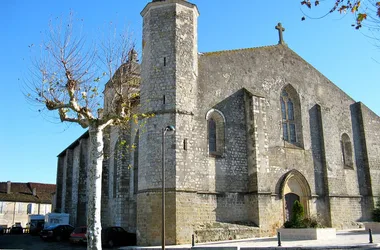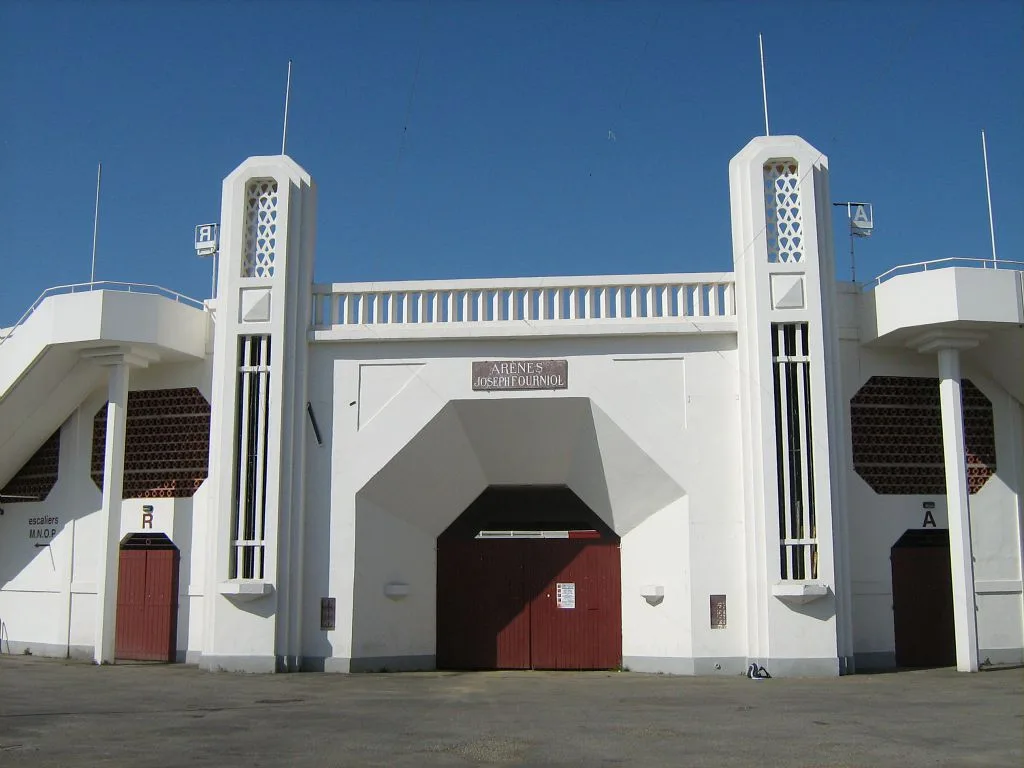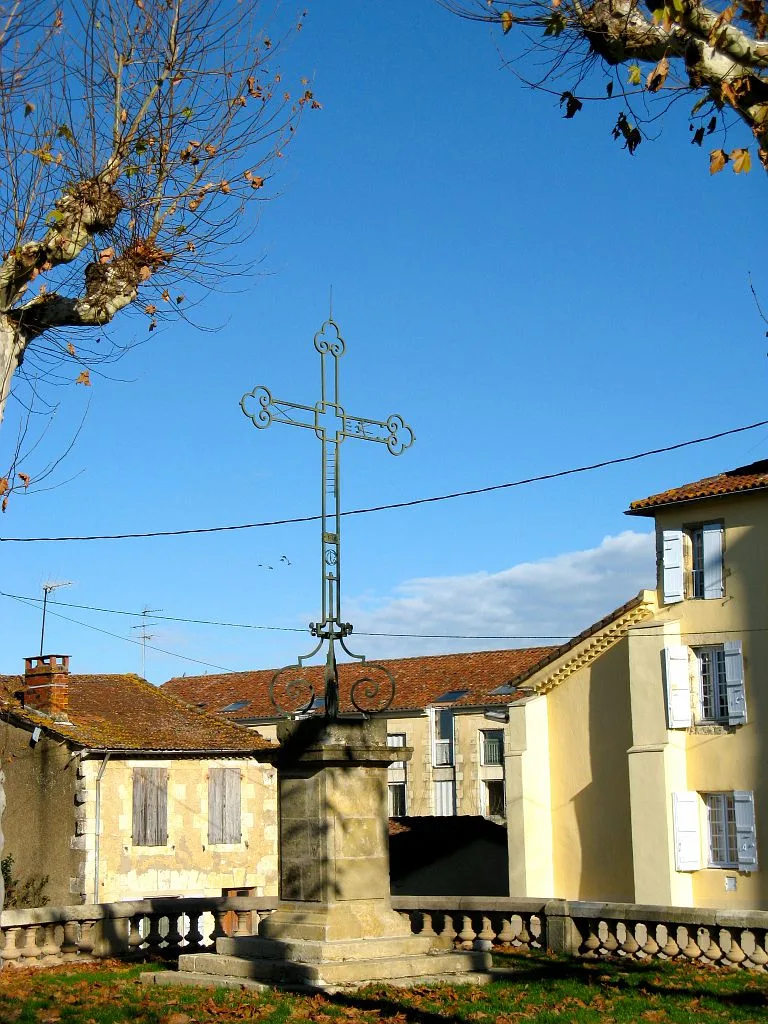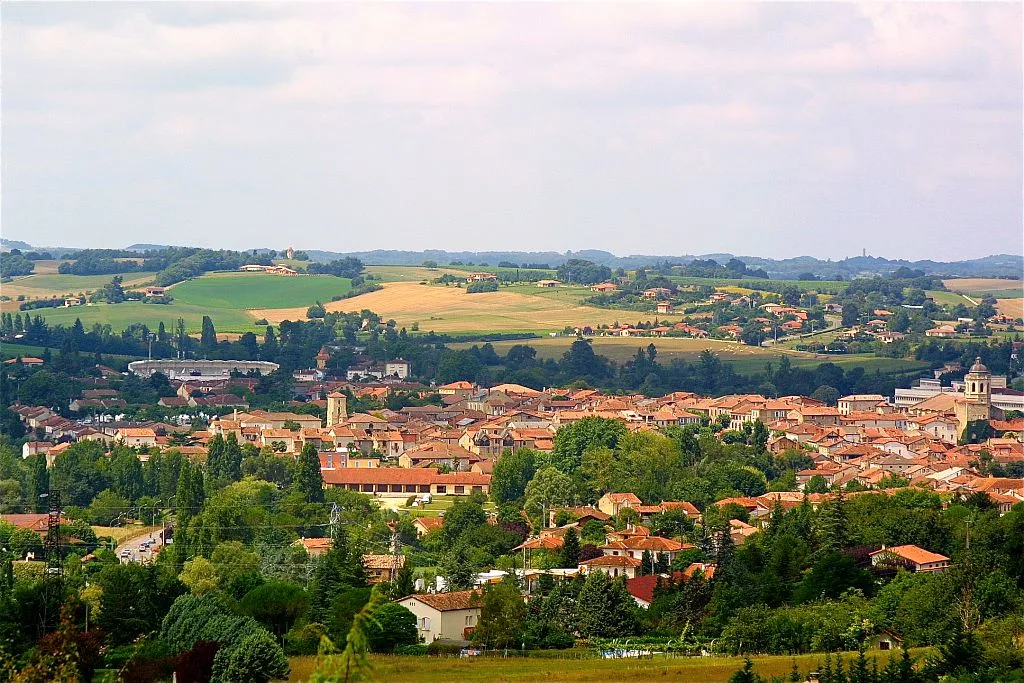Vic-Fezensac, known for its Pentecost ferias and its Tempo Latino festival in July.
Prehistory :
in Vic, traces of the Neolithic (8000 to 5000 BC) were discovered on the site of Saint Jean de Castets (Route de Riguepeu).
The ancient period:
In Roman times, a road station “Besino”, on the site of the current cemetery, was a stopover between “Elimberris” (Auch) and “Eluza” (Eauze).
The Middle Age
During the Merovingian era, still on the same location, “le Masviel” was the first installation of the old Vic. After the barbarian invasions, a “Vicus” was established, a village not defended by walls. Place and site gave rise to a town first named “Fidentia” after the Gallo-Roman owner Fidentius who subsequently became “Fezensac”. The “Vic-Fezensac” was born. It is presented in bipolar form: the castelnau around the count's castle to the south of the current town, and the rescue around the church further north. The fairs are held on the vacant land left between the two. Sauveté and Castelnau came together in the XNUMXth century to form a single town which was entered through eight gates. Between relegation and expansion, Vic found itself with four new districts: the Capots district, the Saint-Jacques hospital district on the banks of the Osse, the Porte-Dessus district and the Barry district (suburb of beyond). of Osse).
The modern period:
In the 1426th century the city was already divided into six districts and in 1866, a hall was built in the middle of the fairground (hall demolished in 1908, making way in XNUMX for the bandstand). In the XNUMXth century, the intendant of Etigny built the road linking Toulouse to Bayonne, changing the course of the Osse and the appearance of the old town.
Modern period :
The XNUMXth and XNUMXth centuries brought new neighborhoods, new communication routes and infrastructure in all areas to Vic. This could not be done without causing destruction.
The attentive visitor can discover, scattered throughout the city, monuments or traces of a past steeped in history.
Religious heritage:
1 – Saint-Pierre church
It is located on the site of the primitive church established in the 1190th century, rebuilt around 1757 and remodeled over the centuries, particularly at the beginning of the 1826th century. You can admire the main altar of Saint-Pierre with its beautiful red marble columns (1680), the altar of Saint Joseph with its altarpiece from XNUMX, the altar of Notre-Dame-de-Pitié (XNUMX), the art deco stained glass windows (north and
south of the nave) due to the Parisian master glassmaker Raphaël Lardeur (1936), the baptismal fonts cut from a single block of marble classified as a historic monument, the great organ (1858), the magnificent wooden frame in the shape of an inverted hull dating from the XNUMXth century century. A XNUMXth century fresco adorns the dome and the walls of the south apse. There are no less than fifteen varieties of marble in this church.
2 – The Chapter Tower
Of the chapter, which existed before 1089, only the square and unfinished tower remains, rebuilt in the XNUMXth century, which replaced the original XNUMXth century cloister. The visitor must take the rue du Triomphe to see on the east facade in its upper part, trefoiled and twin windows and, in the middle, mullioned windows.
4 – The Cordeliers convent
A few steps from the count's castle, at the end of the XNUMXth century, Jean III Count of Armagnac had the building built, the bell tower and the pointed door of the chapel of the old rural hospital can still be seen
(founded by Albert Deluc at the beginning of the 1833th century). Engraved tombstones from the XNUMXth century are embedded here and there in the walls. inside, above the altar, there is a stucco sculptural group representing the Assumption and offered in XNUMX by the Chevalier de Rivière. (We cannot currently visit the interior of the chapel for security reasons).
5 – The Capuchin convent
In the middle of the XNUMXth century it became an important building built with stones from the old castle. Sold as national property, it now houses housing and businesses.
6 – The Notre-Dame monastery
Built by the Premonstratensians in the XNUMXth century, it was the first hospital in Vic, a refuge for pilgrims and the poor. The estate was used as a barn then was transformed into a castle in the XNUMXth century (private property). On the door of the chapel we see beautiful capitals dating from the XNUMXth century and, opposite, on the walls of the castle, two openings with trilobed ribs, twinned in a Gothic style radiating from the same period. (Recovery of the Haut Maguit church).
7 – The Crosses
Wrought iron cross next to the church; Cross of the Virgin in stone in Carboire on the D35; Glacière crossroads cross in tuff dedicated to the Sacré-Coeur (1802); Goulin stone cross.
8 – The old cemetery
Beautiful tombs characteristic of each era erected by individuals or famous Vicois including the tomb of Doctor Delucq (mayor of Vic from 1904 to 1944) topped with a sphinx.
Civil heritage
9 – The arenas
They bear the name of Joseph Fourniol who, with Alfred Degeil (Aguillita), was the pioneer of Vicois aficion. In the callejon, to the right of the presidency, a plaque bears the following inscription: "in memory of Aguillita whose cult for the toro de lidia made it possible to make the small plaza de Vic into a large French plaza". The visitor is greeted by a life-size statue (1990) representing the bullfighter Ruiz Miguel in front of a toro by Victorino Martin. A plaque honoring the memory of President Jean-Jacques Baylac has been placed on the Sorteo patio since Pentecost 2011.
The arenas are the ideal location for various events (bullfights, Landes races, concerts, festivals, etc.)
10 – The Saint-Jacques tower
The St Jacques Tower or Barry Tower, the only vestige of the Saint-Jacques hospital, contains a spiral stone staircase from the mid-XNUMXth century (not visible at the moment) and has braced windows from the same period.
11 – The kiosk
Located on the site of the old market hall and designed by the local architect M.Castéra, it was created by M.Carsalade, a Vicois craftsman, and was inaugurated in 1908.
12 – Bridges
That of Etigny in stone (1759), the Notre-Dame bridge built before the revolution on the old Roman road and the “Eiffel-style” bridge (1897), a metal bridge on the route of the old hospital spanning the Osse . That of Teulère (1909), Pont de la Glacière (1908), Notre-Dame viaduct (only two arches out of five remain), private and Tunnel de l'Argenté (private).
13 – The wash houses
Of the 9 wash houses built in the middle of the 3th century, only XNUMX have been saved: the “Pétopaou” wash house (private), the Goulin wash house and the “La Glacière” wash house as it was originally.
14 – Wells and fountains
There are public wells: at Camin de la Halhera, rue du Puis au Barry. In Vic, water supply has always been a major problem. In 1953 with the end of the water supply works, the fountains were gradually abandoned.
You can see those of Goulin, Saint Pierre, Place G.Séailles, Rue des Cordeliers.
15 – The old tower
Fortification tower, built in the XNUMXth century, demolished during the construction of the new town hall (a section of wall is visible behind it).
16 – Neighborhood houses
From the Middle Ages, there remain a few half-timbered houses and some corbelled above the street: the “carrelots”, still numerous in Vic and bearing colorful names in Gascon. In the 1582th century, it was no longer permitted to encroach on the central square belonging to the community but from 1648 to XNUMX the consuls authorized the construction of houses with arcades and angles constituting a garland which in Vic was called "the arches".
In the XNUMXth century, along Rue de la République, beautiful stone houses were built with their cast iron or wrought iron balconies.
17 – Houses steeped in history
The house where Louis XIV slept on his way to St Jean de Luz to get married there in 1660 (7 rue Henri Rougeon); The Cassaignolles house, named after a family of notable Vicois who produced great servants of the state (29 rue Cassaignolles); The former Dumestre secondary school (rue Lebbé Frères); The house at n°10 Place Julie Saint Avit under the arches with its remains of the count's castle.
18 – The war memorial
Located next to the church, inaugurated in 1924, is a bas-relief of Malric of great humanity, rooted in the local context.
19 – The statue of Zadkine
“The Messenger”: This work, placed inside the Vic Town Hall, sits on a stone base emblazoned with the coats of arms of Paris and Vic.
20 – Furniture on display at the town hall
Around twenty pictorial works; statues ; a civil bell cast in Vic in 1509 “selected by the campanary museum to be exhibited in Beijing in 2005”.
21 – The Vicois castles
Notre-Dame, Bautian, Le Boutet, Carget, Gimat, and Le Pimbat route d'Auch which can be visited by appointment.
For the history lover and the curious, the list drawn up is far from exhaustive and constantly needs to be supplemented.
sources:
– Zacharie Baqué, “Story of Vic”
– “Vic-Fezensac, centuries of history” (Local section of the Archaeological Society of Gers)
– Municipal archives (can be consulted at the town hall)
in Vic, traces of the Neolithic (8000 to 5000 BC) were discovered on the site of Saint Jean de Castets (Route de Riguepeu).
The ancient period:
In Roman times, a road station “Besino”, on the site of the current cemetery, was a stopover between “Elimberris” (Auch) and “Eluza” (Eauze).
The Middle Age
During the Merovingian era, still on the same location, “le Masviel” was the first installation of the old Vic. After the barbarian invasions, a “Vicus” was established, a village not defended by walls. Place and site gave rise to a town first named “Fidentia” after the Gallo-Roman owner Fidentius who subsequently became “Fezensac”. The “Vic-Fezensac” was born. It is presented in bipolar form: the castelnau around the count's castle to the south of the current town, and the rescue around the church further north. The fairs are held on the vacant land left between the two. Sauveté and Castelnau came together in the XNUMXth century to form a single town which was entered through eight gates. Between relegation and expansion, Vic found itself with four new districts: the Capots district, the Saint-Jacques hospital district on the banks of the Osse, the Porte-Dessus district and the Barry district (suburb of beyond). of Osse).
The modern period:
In the 1426th century the city was already divided into six districts and in 1866, a hall was built in the middle of the fairground (hall demolished in 1908, making way in XNUMX for the bandstand). In the XNUMXth century, the intendant of Etigny built the road linking Toulouse to Bayonne, changing the course of the Osse and the appearance of the old town.
Modern period :
The XNUMXth and XNUMXth centuries brought new neighborhoods, new communication routes and infrastructure in all areas to Vic. This could not be done without causing destruction.
The attentive visitor can discover, scattered throughout the city, monuments or traces of a past steeped in history.
Religious heritage:
1 – Saint-Pierre church
It is located on the site of the primitive church established in the 1190th century, rebuilt around 1757 and remodeled over the centuries, particularly at the beginning of the 1826th century. You can admire the main altar of Saint-Pierre with its beautiful red marble columns (1680), the altar of Saint Joseph with its altarpiece from XNUMX, the altar of Notre-Dame-de-Pitié (XNUMX), the art deco stained glass windows (north and
south of the nave) due to the Parisian master glassmaker Raphaël Lardeur (1936), the baptismal fonts cut from a single block of marble classified as a historic monument, the great organ (1858), the magnificent wooden frame in the shape of an inverted hull dating from the XNUMXth century century. A XNUMXth century fresco adorns the dome and the walls of the south apse. There are no less than fifteen varieties of marble in this church.
2 – The Chapter Tower
Of the chapter, which existed before 1089, only the square and unfinished tower remains, rebuilt in the XNUMXth century, which replaced the original XNUMXth century cloister. The visitor must take the rue du Triomphe to see on the east facade in its upper part, trefoiled and twin windows and, in the middle, mullioned windows.
4 – The Cordeliers convent
A few steps from the count's castle, at the end of the XNUMXth century, Jean III Count of Armagnac had the building built, the bell tower and the pointed door of the chapel of the old rural hospital can still be seen
(founded by Albert Deluc at the beginning of the 1833th century). Engraved tombstones from the XNUMXth century are embedded here and there in the walls. inside, above the altar, there is a stucco sculptural group representing the Assumption and offered in XNUMX by the Chevalier de Rivière. (We cannot currently visit the interior of the chapel for security reasons).
5 – The Capuchin convent
In the middle of the XNUMXth century it became an important building built with stones from the old castle. Sold as national property, it now houses housing and businesses.
6 – The Notre-Dame monastery
Built by the Premonstratensians in the XNUMXth century, it was the first hospital in Vic, a refuge for pilgrims and the poor. The estate was used as a barn then was transformed into a castle in the XNUMXth century (private property). On the door of the chapel we see beautiful capitals dating from the XNUMXth century and, opposite, on the walls of the castle, two openings with trilobed ribs, twinned in a Gothic style radiating from the same period. (Recovery of the Haut Maguit church).
7 – The Crosses
Wrought iron cross next to the church; Cross of the Virgin in stone in Carboire on the D35; Glacière crossroads cross in tuff dedicated to the Sacré-Coeur (1802); Goulin stone cross.
8 – The old cemetery
Beautiful tombs characteristic of each era erected by individuals or famous Vicois including the tomb of Doctor Delucq (mayor of Vic from 1904 to 1944) topped with a sphinx.
Civil heritage
9 – The arenas
They bear the name of Joseph Fourniol who, with Alfred Degeil (Aguillita), was the pioneer of Vicois aficion. In the callejon, to the right of the presidency, a plaque bears the following inscription: "in memory of Aguillita whose cult for the toro de lidia made it possible to make the small plaza de Vic into a large French plaza". The visitor is greeted by a life-size statue (1990) representing the bullfighter Ruiz Miguel in front of a toro by Victorino Martin. A plaque honoring the memory of President Jean-Jacques Baylac has been placed on the Sorteo patio since Pentecost 2011.
The arenas are the ideal location for various events (bullfights, Landes races, concerts, festivals, etc.)
10 – The Saint-Jacques tower
The St Jacques Tower or Barry Tower, the only vestige of the Saint-Jacques hospital, contains a spiral stone staircase from the mid-XNUMXth century (not visible at the moment) and has braced windows from the same period.
11 – The kiosk
Located on the site of the old market hall and designed by the local architect M.Castéra, it was created by M.Carsalade, a Vicois craftsman, and was inaugurated in 1908.
12 – Bridges
That of Etigny in stone (1759), the Notre-Dame bridge built before the revolution on the old Roman road and the “Eiffel-style” bridge (1897), a metal bridge on the route of the old hospital spanning the Osse . That of Teulère (1909), Pont de la Glacière (1908), Notre-Dame viaduct (only two arches out of five remain), private and Tunnel de l'Argenté (private).
13 – The wash houses
Of the 9 wash houses built in the middle of the 3th century, only XNUMX have been saved: the “Pétopaou” wash house (private), the Goulin wash house and the “La Glacière” wash house as it was originally.
14 – Wells and fountains
There are public wells: at Camin de la Halhera, rue du Puis au Barry. In Vic, water supply has always been a major problem. In 1953 with the end of the water supply works, the fountains were gradually abandoned.
You can see those of Goulin, Saint Pierre, Place G.Séailles, Rue des Cordeliers.
15 – The old tower
Fortification tower, built in the XNUMXth century, demolished during the construction of the new town hall (a section of wall is visible behind it).
16 – Neighborhood houses
From the Middle Ages, there remain a few half-timbered houses and some corbelled above the street: the “carrelots”, still numerous in Vic and bearing colorful names in Gascon. In the 1582th century, it was no longer permitted to encroach on the central square belonging to the community but from 1648 to XNUMX the consuls authorized the construction of houses with arcades and angles constituting a garland which in Vic was called "the arches".
In the XNUMXth century, along Rue de la République, beautiful stone houses were built with their cast iron or wrought iron balconies.
17 – Houses steeped in history
The house where Louis XIV slept on his way to St Jean de Luz to get married there in 1660 (7 rue Henri Rougeon); The Cassaignolles house, named after a family of notable Vicois who produced great servants of the state (29 rue Cassaignolles); The former Dumestre secondary school (rue Lebbé Frères); The house at n°10 Place Julie Saint Avit under the arches with its remains of the count's castle.
18 – The war memorial
Located next to the church, inaugurated in 1924, is a bas-relief of Malric of great humanity, rooted in the local context.
19 – The statue of Zadkine
“The Messenger”: This work, placed inside the Vic Town Hall, sits on a stone base emblazoned with the coats of arms of Paris and Vic.
20 – Furniture on display at the town hall
Around twenty pictorial works; statues ; a civil bell cast in Vic in 1509 “selected by the campanary museum to be exhibited in Beijing in 2005”.
21 – The Vicois castles
Notre-Dame, Bautian, Le Boutet, Carget, Gimat, and Le Pimbat route d'Auch which can be visited by appointment.
For the history lover and the curious, the list drawn up is far from exhaustive and constantly needs to be supplemented.
sources:
– Zacharie Baqué, “Story of Vic”
– “Vic-Fezensac, centuries of history” (Local section of the Archaeological Society of Gers)
– Municipal archives (can be consulted at the town hall)







